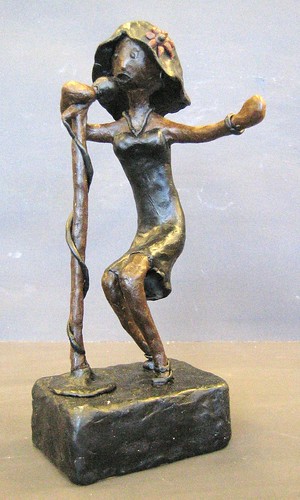
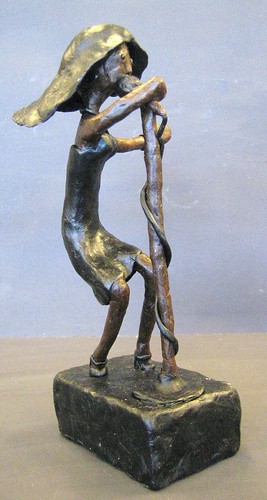
Singer
Work in wax by a 15 yold student diagnosed with ODD and ADHD
The loss of the village
In his blog "Obedience" Andrew Old beefs about disobedience in the classroom, and rightly so. Without students' accepting that the teacher is the alpha person education is impossible. Andrew's arguments point at a ubiquitous slackness in Western culture. An African saying tells us: "It takes a village to raise a child". Apparently we are no villagers any more and children are at a loss in a highly individualised global city. The result is mayhem in the classroom.
Extreme behaviour
In the extreme the problem is represented by the definition of Oppositional Defiant Disorder:
- frequent temper tantrums
- excessive arguing with adults
- active defiance and refusal to comply with adult requests and rules
- deliberate attempts to annoy or upset people
- blaming others for his or her mistakes or misbehavior
- often being touchy or easily annoyed by others
- frequent anger and resentment
- mean and hateful talking when upset
- seeking revenge
This behaviour is connected with neurological disorder. This makes sense: in all cultures of all times some people have been behaving anti-socially. These troublesome kids are in real danger of becoming criminals, or greedy bankers for that matter. Every so often we have one of them in our classrooms.
A lot of lunatics?
Albeit, I can't buy the percentage of kids purportedly suffering from this condition: five to fifteen percent of all school-age children. That's an outrageous number and it does not match my experience of over thirty years of teaching. I do not expect all children to be obedient and meek all of the time. I am an educator and it is part and parcel of my calling to correct poor behaviour, laziness, heckles, foul language and solipsistic ideas. I teach young adolescents after all. The predominance of pupils are reasonable and willing to learn, I can communicate with them and enjoy them, knowing that they will outgrow insolence and petulance.
To the detriment of lessons
In my tutor group I have a girl who has been diagnosed with ODD and ADHD. Dutch governmental policy has it to place children with special needs in the normal classroom. This child may benefit from the example of other children, at least she realises that her behaviour is not considered to be normal. However, her condition seems to be contagious. Some other students take pleasure in the aggro caused by her histrionics and one boy shows copycat behaviour. Teachers are harried, parents complain about the learning environment of their children. At the end of this year the girl will have to leave the school because she cannot meet our academic standards and can not be promoted to the next form. I have no doubts about her innate intelligence, she falls behind because she cannot concentrate and work on a daily basis. She does not accept guidance.
The singer in wax
The art work shown in the images above was done by this girl. To my amazement she worked on it for several hours fully concentrated. Whenever she has set a goal for her art work all symptoms of her neurological disorder disappear. Provided she has an interest in the topic at hand she will work at her drawing or sculpture with rapt attention over a prolonged period. I advised her to aim for a career as an artist. She is not extremely gifted, but she is capable of producing interesting work. Even more important, in the arts a highly eccentric personality is not uncommon and will be accepted more easily. This might give her a chance to find a place in society. But she baulked at the prospect of having to spend time on art theory and art history.
Don't blame the teacher
Bearing in mind that ODD, ADHD, PDDNOS and all those other afflictions described in DSM IV do exist and have a base in physical disorders that can be detected and measured by scans, I am inclined to think that the number of students suffering from these conditions is highly exaggerated. By medicalising anti-social behaviour our society denies the underlying problem: too many parents fail to discipline their children properly in a stable and safe environment. Because of inadequate caring, excessive consumerism and lack of rules lots of children do not develop a sound personality. As a result they cannot communicate reciprocally. Emotionally they keep functioning on the level of a three year old child.
Teachers cannot solve this problem at a later stage.







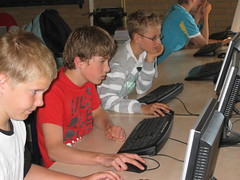 Today two guests covered a lesson of mine. My first formers were to participate in scientific research in which their perception while gaming at the computer was questioned, in particular their awareness of advertisement pop-ups at the edge of the screen.
Today two guests covered a lesson of mine. My first formers were to participate in scientific research in which their perception while gaming at the computer was questioned, in particular their awareness of advertisement pop-ups at the edge of the screen.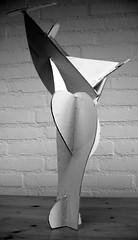

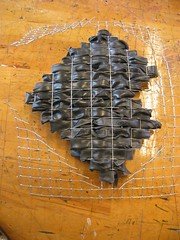
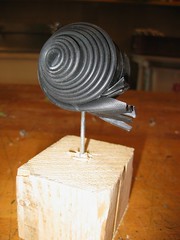
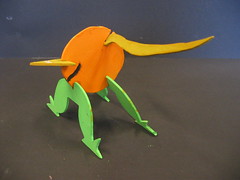 Every so often a teacher strikes a chord with his students. The animal in the picture has been made by a thirteen year old girl. The hybrid animal, assembled out of plywood parts and subsequently painted, shows that she has grasped the idea that art is not just about imitating reality. She created an object that conjures up a completely new and mindboggling creature.
Every so often a teacher strikes a chord with his students. The animal in the picture has been made by a thirteen year old girl. The hybrid animal, assembled out of plywood parts and subsequently painted, shows that she has grasped the idea that art is not just about imitating reality. She created an object that conjures up a completely new and mindboggling creature.

